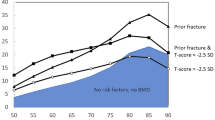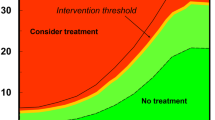Abstract
This paper reviews briefly the development and clinical use of FRAX® in the development of assessment guidelines for osteoporosis.
Fractures are the clinical consequence of osteoporosis and are a major cause of morbidity and mortality worldwide. Several treatments are available that have been shown to decrease the risk of fracture, but problems arise in identifying individuals at high fracture risk so that treatments can be effectively targeted. Case finding can be enhanced by the consideration of clinical risk factors that provide information on fracture risk over and above that provided by bone mineral density measurements. The FRAX tool integrates information on fracture risk from clinical risk factors with or without the use of BMD and can be used to improve the targeting of individuals at high fracture risk.



Similar content being viewed by others
References
Kanis JA, on behalf of the World Health Organization Scientific Group (2008) Assessment of osteoporosis at the primary health-care level. Technical Report. WHO Collaborating Centre, University of Sheffield, UK
Kanis JA, Johnell O, Oden A, Sernbo I, Redlund-Johnell I, Dawson A, de Laet C, Jonsson B (2000) Long-term risk of osteoporotic fractures in Malmo. Osteoporis Int 11:669–674
Melton LJ 3rd (2003) Adverse outcomes of osteoporotic fractures in the general population. J Bone Miner Res 18:1139–1141
Kanis JA, Burlet N, Cooper C, on behalf of the European Society for Clinical and Economic Aspects of Osteoporosis and Osteoarthritis (ESCEO) et al (2008) European guidance for the diagnosis and management of osteoporosis in postmenopausal women. Osteoporos Int 19:399–428
Boonen S, Body JJ, Boutsen Y, Devogelaer JP, Goemaere S, Kaufman JM et al (2005) Evidence-based guidelines for the treatment of postmenopausal osteoporosis: a consensus document of the Belgian Bone Club. Osteoporos Int 16:239–254
Kanis JA (2002) Diagnosis of osteoporosis and assessment of fracture risk. Lancet 359:1929–1936
Hui SL, Slemenda CW, Johnston CC (1988) Age and bone mass as predictors of fracture in a prospective study. J Clin Invest 81:1804–1809
Kanis JA, Johnell O, Oden A, Dawson A, De Laet C, Jonsson B (2001) Ten year probabilities of osteoporotic fractures according to BMD and diagnostic thresholds. Osteoporos Int 12:989–995
Kanis JA, Borgstrom F, De Laet C et al (2005) Assessment of fracture risk. Osteoporos Int 16:581–589
Kanis JA, Black D, Cooper C, Dargent P, Dawson-Hughes B, De Laet C (2002) A new approach to the development of assessment guidelines for osteoporosis. Osteoporosis Int 13:527–536
De Laet C, Kanis JA, Oden A et al (2005) Body mass index as a predictor of fracture risk: a meta-analysis. Osteoporos Int 16:1330–1338
Kanis JA, Johnell O, De Laet C et al (2004) A meta-analysis of previous fracture and subsequent fracture risk. Bone 35:375–382
Kanis JA, Johansson H, Oden A et al (2004) A family history of fracture and fracture risk: a meta-analysis. Bone 35:1029–1037
Kanis JA, Johnell O, Oden A et al (2006) Smoking and fracture risk: a meta-analysis. Osteoporos Int 16:155–162
Kanis JA, Johansson H, Oden A et al (2000) A meta-analysis of prior corticosteroid use and fracture risk. J Bone Miner Res 19:893–899
Kanis JA, Johansson H, Johnell O et al (2005) Alcohol intake as a risk factor for fracture. Osteoporos Int 16:737–742
Kanis JA, Oden A, Johnell O et al (2007) The use of clinical risk factors enhances the performance of BMD in the prediction of hip and osteoporotic fractures in men and women. Osteoporos Int 18:1033–1046
Kanis JA, Johnell O, De Laet C, Jonnson B, Oden A, Ogelsby AK (2002) International variations in hip fracture probability: implications for risk assessment. J Bone Miner Res 17:1237–1244
World Health Organization (2007) Assessment of osteoporosis at the primary health care level. Summary Report of a WHO Scientific Group. WHO, Geneva, www.who.int/chp/topics/rheumatic/en/index.html
Kanis JA, McCloskey EV, Johansson H, the National Osteoporosis Guideline Group (2009) Case finding for the management of osteoporosis with FRAX®—assessment and intervention thresholds for the UK. Osteoporos Int 19:1395–1408, Erratum published 2009 Osteoporos Int 20, 499-502
Siminoski K, Leslie WD, Frame H et al (2007) Recommendations for bone mineral density reporting in Canada: a shift to absolute fracture risk assessment. J Clin Densitom 10:120–123
Fujiwara S, Nakamura T, Orimo H, Hosoi T, Gorai I, Oden A et al (2008) Development and application of a Japanese model of the WHO fracture risk assessment tool (FRAX™). Osteoporos Int 19:429–448
Kurth AA, Pfeilschifter J (2007) Diagnosis and treatment of postmenopausal osteoporosis and osteoporosis in men. German Guidelines Update 2006. Orthopade 36:683–90, German
Dawson-Hughes B, Tosteson AN, Melton LJ 3rd, Baim S, Favus MJ, Khosla S et al (2008) Implications of absolute fracture risk assessment for osteoporosis practice guidelines in the USA. Osteoporos Int 19:449–458
Siris E, Delmas PD (2008) Assessment of 10-year absolute risk: a new paradigm with worldwide application. Osteoporos Int 19:383–384
Johansson H, Kanis JA, Borgström F, Ström O, Svensson O, Mellström D (2010) FRAX® ett stöd för frakturprevention. Läkartidningen, in press
Royal College of Physicians (1999) Osteoporosis: clinical guidelines for the prevention and treatment. Royal College of Physicians, London
Royal College of Physicians and Bone and Tooth Society of Great Britain (2000) Update on pharmacological interventions and an algorithm for management. Royal College of Physicians, London, UK
Royal College of Physicians (2002) Glucocorticoid-induced osteoporosis. Guidelines on prevention and treatment. Bone and Tooth Society of Great Britain, National Osteoporosis Society and Royal College of Physicians. Royal College of Physicians, London, UK
Kanis JA, Adams J, Borgström F, Cooper C, Jönsson B, Preedy D et al (2008) The cost-effectiveness of alendronate in the management of osteoporosis. Bone 42:4–15
Kanis JA, Stevenson M, McCloskey EV, Davis S, Lloyd-Jones M (2007) Glucocorticoid-induced osteoporosis: a systematic review and cost-utility analysis. Health Technol Assess 11:1–256
Kanis JA, Johnell O, on behalf of the Committee of Scientific Advisors of the International Osteoporosis Foundation (2005) Requirements for DXA for the management of osteoporosis in Europe. Osteoporos Int 16:229–238
National Osteoporosis Guideline Group on behalf of the Bone Research Society, British Geriatrics Society, British Society of Rheumatology, Society of Endocrinology, British Orthopaedic Association, Primary Care Rheumatology Society, Osteoporosis 2000 and Osteoporosis Dorset (2008) Osteoporosis: clinical guideline for prevention and treatment. University of Sheffield Press, Sheffield
Tsang SWY, Kanis KAWC, JA JH, Oden A (2009) Ten-year fracture probability in Hong Kong southern Chinese according to age and BMD femoral neck T-scores. Osteoporos Int 20:1939–1945
Czerwiński E, Badurski JE, Marcinowska-Suchowierska E, Osieleniec J (2007) Current understanding of osteoporosis according to the position of the World Health Organization (WHO) and International Osteoporosis Foundation. Ortop Traumatol Rehabil 9:337–356
Lippuner K, Johansson H, Kanis JA, Rizzoli R (2010) FRAX assessment of osteoporotic fracture probability in Switzerland. Osteoporos Int 21:381–390
Neuprez A, Johansson H, Kanis JA et al (2009) A FRAX model for the assessment of fracture probability in Belgium. Rev Med Liege 64:612–619
National Osteoporosis Foundation (NOF) (2008) Clinician’s Guide to prevention and treatment of osteoporosis. National Osteoporosis Foundation, National Osteoporosis Foundation Washington www.nof.org
Tosteson AN, Melton LJ 3rd, Dawson-Hughes B, Baim S, Favus MJ, Khosla S et al (2008) National Osteoporosis Foundation Guide Committee. Cost-effective osteoporosis treatment thresholds: the United States perspective. Osteoporos Int 19:437–447
Committee for Medicinal Products for Human Use (CHMP) (2006) Guideline on the evaluation of medicinal products in the treatment of primary osteoporosis. Ref CPMP/EWP/552/95Rev.2. London, CHMP
McCloskey EV, Johansson H, Oden A et al (2009) Ten-year fracture probability identifies women who will benefit from clodronate therapy—additional results from a double blind, placebo controlled randomised study. Osteoporos Int 20:811–818
Kanis JA, Johansson H, Oden A, McCloskey EV (2009) Bazedoxifene reduces vertebral and clinical fractures in postmenopausal women at high risk assessed with FRAX®. Bone 44:49–54
Conflicts of interest
None.
Author information
Authors and Affiliations
Corresponding author
Rights and permissions
About this article
Cite this article
Kanis, J.A., McCloskey, E.V., Johansson, H. et al. Development and use of FRAX® in osteoporosis. Osteoporos Int 21 (Suppl 2), 407–413 (2010). https://doi.org/10.1007/s00198-010-1253-y
Received:
Accepted:
Published:
Issue Date:
DOI: https://doi.org/10.1007/s00198-010-1253-y




